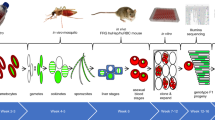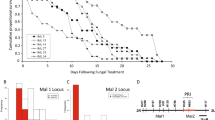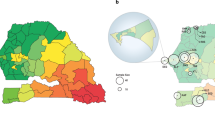Abstract
Malaria is a major infectious disease worldwide, with over 1 million deaths in African children every year. The molecular pathways of pathogenesis of the Plasmodium parasite and the host mechanisms of defense against this infection remain poorly understood. Epidemiological studies, together with linkage analyses in endemic areas have clearly pointed at a genetic component of innate susceptibility and severity of disease. In humans, this genetic trait is complex, and has been studied in a mouse experimental model over the past few years. Inbred strains of mice show different degrees of susceptibility to infection with Plasmodium chabaudi, and the genetic component of these inter-strain differences has been studied in standard informative backcross and F2 populations, as well as in recombinant inbred strains and more recently, in recombinant congenic strains. These studies have shown that genetic susceptibility to malaria is also complex in mice, and have led to the mapping of major susceptibility Char (Chabaudi resistance) loci, located on chromosomes 9 (Char1), 8 (Char2), 17 (Char3) and 3 (Char4).
This is a preview of subscription content, access via your institution
Access options
Subscribe to this journal
Receive 6 digital issues and online access to articles
$119.00 per year
only $19.83 per issue
Buy this article
- Purchase on Springer Link
- Instant access to full article PDF
Prices may be subject to local taxes which are calculated during checkout






Similar content being viewed by others
References
Butler D . Time to put malaria control on the global agenda Nature 1997 386: 535–536
www.who.ch
Marsh K . 30 years of science and technology: the example of malaria The Lancet 1997 349: SIII1–SIII2
Hill AV . The immunogenetics of human infectious diseases Annu Rev Immunol 1998 16: 593–617
Mohan K, Stevenson MM . In: Sherman IW (ed) Malaria American Society for Microbiology: Washington, DC 1998 467–493
Kwiatkowski D . Genetic susceptibility to malaria getting complex Curr Opin Genet Dev 2000 10: 320–324
Taylor JG, Ferdig MT, Su XZ, Wellems TE . Toward quantitative genetic analysis of host and parasite traits in the manifestations of Plasmodium falciparum malaria Curr Opin Genet Dev 2000 10: 314–319
Modiano D, Petrarca V, Sirima BS et al. Different response to Plasmodium falciparum malaria in west African sympatric ethnic groups Proc Natl Acad Sci USA 1996 93: 13206–13211
Abel L, Cot M, Mulder L, Carnevale P, Feingold J . Segregation analysis detects a major gene controlling blood infection levels in human malaria Am J Hum Genet 1992 50: 1308–1317
Garcia A, Cot M, Chippaux JP et al. Genetic control of blood infection levels in human malaria: evidence for a complex genetic model Am J Trop Med Hyg 1998 58: 480–488
Rihet P, Abel L, Traore Y, Traore-Leroux T, Aucan C, Fumoux F . Human malaria: segregation analysis of blood infection levels in a suburban area and a rural area in Burkina Faso Genet Epidemiol 1998 15: 435–450
Rihet P, Traore Y, Abel L, Aucan C, Traore-Leroux T, Fumoux F . Malaria in humans: Plasmodium falciparum blood infection levels are linked to chromosome 5q31-q33 Am J Hum Genet 1998 63: 498–505
Stirnadel HA, Beck HP, Alpers MP, Smith TA . Heritability and segregation analysis of immune responses to specific malaria antigens in Papua New Guinea Genet Epidemiol 1999 17: 16–34
Sjoberg K, Lepers JP, Raharimalala L et al. Genetic regulation of human anti-malarial antibodies in twins Proc Natl Acad Sci USA 1992 89: 2101–2104
Aucan C, Traore Y, Fumoux F, Rihet P . Familial correlation of immunoglobulin G subclass responses to Plasmodium flaciparum antigens in Burkina Faso Infect Immun 2001 69: 996–1001
Jepson AP, Banya WA, Sisay-Joof F, Hassan-King M, Bennett S, Whittle HC . Genetic regulation of fever in Plasmodium falciparum malaria in Gambian twin children J Infect Dis 1995 172: 316–319
Jepson A, Sisay-Joof F, Banya W et al. Genetic linkage of mild malaria to the major histocompatibility complex in Gambian children: study of affected sibling pairs BMJ 1997 315: 96–97
Tournamille C, Colin Y, Cartron JP, Le Van Kim C . Disruption of a GATA motif in the Duffy gene promoter abolishes erythroid gene expression in Duffy-negative individuals Nat Genet 1995 10: 224–228
Pasvol G, Weatherall DJ, Wilson RJ . Cellular mechanism for the protective effect of haemoglobin S against P. falciparum malaria Nature 1978 274: 701–703
Hill AV, Allsopp CE, Kwiatkowski D et al. Common west African HLA antigens are associated with protection from severe malaria Nature 1991 352: 595–600
Chippaux JP, Massougbodji A, Boulard JC, Akogbeto M . Morbidity and severity of malaria attacks in carriers of sickle-cell trait Rev Epidemiol Sante Publique 1992 40: 240–245
Shear HL, Roth EF Jr, Fabry ME et al. Transgenic mice expressing human sickle hemoglobin are partially resistant to rodent malaria Blood 1993 81: 222–226
Williams TN, Maitland K, Bennett S et al. High incidence of malaria in alpha-thalassaemic children Nature 1996 383: 522–525
Allen SJ, O’Donnell A, Alexander ND et al. alpha+-Thalassemia protects children against disease caused by other infections as well as malaria Proc Natl Acad Sci USA 1997 94: 14736–14741
Weatherall DJ . Phenotype-genotype relationships in monogenic disease: lessons from the thalassaemias Nat Rev Genet 2001 2: 245–255
Ruwende C, Khoo SC, Snow RW et al. Natural selection of hemi- and heterozygotes for G6PD deficiency in Africa by resistance to severe malaria Nature 1995 376: 246–249
Tishkoff SA, Varkonyi R, Cahinhinan N et al. Haplotype diversity and linkage disequilibrium at human G6PD: recent origin of alleles that confer malarial resistance Science 2001 293: 455–462
Wilson AG, Symons JA, McDowell TL, McDevitt HO, Duff GW . Effects of a polymorphism in the human tumor necrosis factor alpha promoter on transcriptional activation Proc Natl Acad Sci USA 1997 94: 3195–3199
McGuire W, Hill AV, Allsopp CE, Greenwood BM, Kwiatkowski D . Variation in the TNF-alpha promoter region associated with susceptibility to cerebral malaria Nature 1994 371: 508–510
McGuire W, Knight JC, Hill AV, Allsopp CE, Greenwood BM, Kwiatkowski D . Severe malarial anemia annd cerebral malaria are associated with different tumor necrosis factor promoter alleles J Infect Dis 1999 179: 287–290
Knight JC, Udalova I, Hill AV et al. A polymorphism that affects OCT-1 binding to the TNF promoter region is associated with severe malaria Nat Genet 1999 22: 145–150
Vidal SM, Malo D, Vogan K, Skamene E, Gros P . Natural resistance to infection with intracellular parasites: isolation of a candidate for Bcg Cell 1993 73: 469–485
Poltorak A, He X, Smirnova I et al. Defective LPS signaling in C3H/HeJ and C57BL/10ScCr mice: mutations in Tlr4 gene Science 1998 282: 2085–2088
Qureshi ST, Lariviere L, Leveque G et al. Endotoxin-tolerant mice have mutations in Toll-like receptor 4 (Tlr4) J Exp Med 1999 189: 615–625
Lee SH, Girard S, Macina D et al. Susceptibility to mouse cytomegalovirus is associated with deletion of an activating natural killer cell receptor of the C-type lectin superfamily Nat Genet 2001 28: 42–45
Brown MG, Dokun AO, Heusel JW et al. Vital involvement of a natural killer cell activation receptor in resistance to viral infection Science 2001 292: 934–937
Taylor-Robinson AW . Regulation of immunity to malaria: valuable lessons learned from murine models Parasitol Today 1995 11: 334–342
Langhorne J, Meding SJ, Eichmann K, Gillard SS . The response of CD4+ T cells to Plasmodium chabaudi chabaudi Immunol Rev 1989 112: 71–94
Podoba JE, Stevenson MM . CD4+ and CD8+ T lymphocytes both contribute to acquired immunity to blood-stage Plasmodium chabaudi AS Infect Immun 1991 59: 51–58
Stevenson MM, Skamene E . Modulation of primary antibody responses to sheep erythrocytes in Plasmodium chabaudi-infected resistant and susceptible mouse strains Infect Immun 1986 54: 600–602
Ahvazi BC, Jacobs P, Stevenson MM . Role of macrophage-derived nitric oxide in suppression of lymphocyte proliferation during blood-stage malaria J Leukoc Biol 1995 58: 23–31
Cox J, Semoff S, Hommel M . Plasmodium chabaudi: a rodent malaria model for in-vivo and in-vitro cytoadherence of malaria parasites in the absence of knobs Parasite Immunol 1987 9: 543–561
Eugui EM, Allison AC . Differences in susceptibility of various mouse strains to haemoprotozoan infections: possible correlation with natural killer activity Parasite Immunol 1980 2: 277–292
Stevenson MM, Lyanga JJ, Skamene E . Murine malaria: genetic control of resistance to Plasmodium chabaudi Infect Immun 1982 38: 80–88
Stevenson MM, Ghadirian E, Phillips NC, Rae D, Podoba JE . Role of mononuclear phagocytes in elimination of Plasmodium chabaudi AS infection Parasite Immunol 1989 11: 529–544
Stevenson MM, Tam MF, Rae D . Dependence on cell-mediated mechanisms for the appearance of crisis forms during Plasmo-dium chabaudi AS infection in C57BL/6 mice Microb Pathog 1990 9: 303–314
Meding SJ, Langhorne J . CD4+ T cells and B cells are necessary for the transfer of protective immunity to Plasmodium chabaudi chabaudi Eur J Immunol 1991 21: 1433–1438
Suss G, Eichmann K, Kury E, Linke A, Langhorne J . Roles of CD4− and CD8− bearing T lymphocytes in the immune response to the erythrocytic stages of Plasmodium chabaudi Infect Immun 1988 56: 3081–3088
Riopel J, Tam M, Mohan K, Marino MW, Stevenson MM . Granulocyte-macrophage colony-stimulating factor-deficient mice have impaired resistance to blood-stage malaria Infect Immun 2001 69: 129–136
Su Z, Stevenson MM . Central role of endogenous gamma interferon in protective immunity against blood-stage Plasmodium chabaudi AS infection Infect Immun 2000 68: 4399–4406
Sam H, Su Z, Stevenson MM . Deficiency in tumor necrosis factor alpha activity does not impair early protective Th1 responses against blood-stage malaria Infect Immun 1999 67: 2660–2664
Nogami S, Watanabe J, Nakagaki K et al. Involvement of macrophage scavenger receptors in protection against murine malaria Am J Trop Med Hyg 1998 59: 843–845
Foote SJ, Burt RA, Baldwin TM et al. Mouse loci for malaria-induced mortality and the control of parasitaemia (letter) Nat Genet 1997 17: 380–381
Wunderlich F, Mossmann H, Helwig M, Schillinger G . Resistance to Plasmodium chabaudi in B10 mice: influence of the H-2 complex and testosterone Infect Immun 1988 56: 2400–2406
Fortin A, Belouchi A, Tam MF et al. Genetic control of blood parasitaemia in mouse malaria maps to chromsome 8 (letter) Nat Genet 1997 17: 382–383
Yap GS, Stevenson MM . Plasmodium chabaudi AS: erythropoietic responses during infection in resistant and susceptible mice Exp Parasitol 1992 75: 340–352
Stevenson MM, Tam MF . Differential induction of helper T cell subsets during blood-stage Plasmodium chabaudi AS infection in resistant and susceptible mice Clin Exp Immunol 1993 92: 77–83
Jacobs P, Radzioch D, Stevenson MM . A Th1-associated increase in tumor necrosis factor alpha expression in the spleen correlates with resistance to blood-stage malaria in mice Infect Immun 1996 64: 535–541
Stevenson MM, Tam MF, Wolf SF, Sher A . IL-12 induced protection against blood-stage Plasmodium chabaudi AS requires IFN-gamma and TNF-alpha and occurs via a nitric oxide-dependent mechanism J Immunol 1995 155: 2545–2556
Mohan K, Stevenson MM . Interleukin-12 corrects severe anemia during blood-stage Plasmodium chabaudi AS in susceptible A/J mice Exp Hematol 1998 26: 45–52
Stevenson MM, Tam MF, Belosevic M, van der Meide PH, Podoba JE . Role of endogenous gamma interferon in host response to infection with blood-stage Plasmodium chabaudi AS Infect Immun 1990 58: 3225–3232
www.jax.org
Burt RA, Baldwin TM, Marshall VM, Foote SJ . Temporal expression of an H2-linked locus in host response to mouse malaria Immunogenetics 1999 50: 278–285
Suzuki H, Kurihara Y, Takeya M et al. A role for macrophage scavenger receptors in atherosclerosis and susceptibility to infection Nature 1997 386: 292–296
Fortin A, Penman M, Stevenson MM, Krieger M, Gros P . Identification and characterization of naturally occurring variants of the macrophage scavenger receptor (SR-A) Mamm Genome 2000 11: 779–785
Daugherty A, Whitman SC, Block AE, Rateri DL . Polymorphism of class A scavenger receptors in C57BL/6 mice J Lipid Res 2000 41: 1568–1577
Demant P, Hart AA . Recombinant congenic strains – a new tool for analyzing genetic traits determined by more than one gene Immunogenetics 1986 24: 416–422
Fortin A, Diez E, Rochefort D et al. Recombinant congenic strains derived from A/J and C57B1/6J: a tool for genetic dissection of complex traits Genomics 2001 74: 21–35
Fortin A, Cardon LR, Tam M, Skamene E, Stevenson MM, Gros P . Identification of a new malaria susceptibility locus (Char4) in recombinant congenic strains of mice Proc Natl Acad Sci USA 2001 98: 10793–10798
Oosterwegel M, van de Wetering M, Timmerman J et al. Differential expression of the HMG box factors TCF-1 and LEF-1 during murine embryogenesis Development 1993 118: 439–448
Galceran J, Farinas I, Depew MJ, Clevers H, Grosschedl R . Wnt3a(−/−)-like phenotype and limb deficiency in Lefl(−/−)Tcfl(−/−) mice Genes Dev 1999 13: 709–717
Minta JO, Wong MJ, Kozak CA, Kunnath-Muglia LM, Goldberger G . cDNA cloning, sequencing and chromosomal assignment of the gene for mouse complement factor I (C3b/C4b inactivator): identification of a species specific divergent segment in factor I Mol Immunol 1996 33: 101–112
Gervais F, Stevenson M, Skamene E . Genetic control of resistance to Listeria monocytogenes: regulation of leukocyte inflammatory responses by the Hc locus J Immunol 1984 132: 2078–2083
Gervais F, Desforges C, Skamene E . The C5-sufficient A/J congenic mouse strain. Inflammatory response and resistance to Listeria monocytogenes J Immunol 1989 142: 2057–2060
Sha WC, Liou HC, Toumanen EI, Baltimore D . Targeted disruption of the p50 subunit of NF-kappa B leads to multifocal defects in immune responses Cell 1995 80: 321–330
Yoshida H, Hayashi S, Kunisada T et al. The murine mutation osteopetrosis is in the coding region of the macrophage colony stimulating factor gene Nature 1990 345: 442–444
Guleria I, Pollard JW . Aberrant macrophage and neutrophil population dynamics and impaired Th1 response to Listeria monocytogenes in colony-stimulating factor 1-deficient mice Infect Immun 2001 69: 1795–1807
Gurtner GC, Davis V, Li H, McCoy MJ, Sharpe A, Cybulsky MI . Targeted disruption of the murine VCAM1 gene: essential role of VCAM-1 in chorioallantoic fusion and placentation Genes Dev 1995 9: 1–14
Koni PA, Joshi SK, Temann UA, Olson D, Burkly L, Flavell RA . Conditional vascular cell adhesion molecule 1 deletion in mice. Impaired lymphocyte migration to bone marrow J Exp Med 2001 193: 741–754
Benten WP, Bettenhaeuser U, Wunderlich F, Van Vliet E, Mossmann H . Testosterone-induced abrogation of self-healing of Plasmodium chabaudi malaria in B10 mice: mediation by spleen cells Infect Immun 1991 59: 4486–4490
Flint J, Mott R . Finding the molecular basis of quantitative traits: successes and pitfalls Nat Rev Genet 2001 2: 437–445
Author information
Authors and Affiliations
Corresponding author
Rights and permissions
About this article
Cite this article
Fortin, A., Stevenson, M. & Gros, P. Complex genetic control of susceptibility to malaria in mice. Genes Immun 3, 177–186 (2002). https://doi.org/10.1038/sj.gene.6363841
Received:
Revised:
Accepted:
Published:
Issue Date:
DOI: https://doi.org/10.1038/sj.gene.6363841
Keywords
This article is cited by
-
Elimination of intravascular thrombi prevents early mortality and reduces gliosis in hyper-inflammatory experimental cerebral malaria
Journal of Neuroinflammation (2018)
-
Selective inhibition of PfA-M1, over PfA-M17, by an amino-benzosuberone derivative blocks malaria parasites development in vitro and in vivo
Malaria Journal (2017)
-
Mesangial proliferative glomerulonephritis in murine malaria parasite, Plasmodium chabaudi AS, infected NC mice
Clinical and Experimental Nephrology (2017)
-
Sex hormones modulate the immune response to Plasmodium berghei ANKA in CBA/Ca mice
Parasitology Research (2015)
-
Susceptibility to lethal cerebral malaria is regulated by epistatic interaction between chromosome 4 (Berr6) and chromosome 1 (Berr7) loci in mice
Genes & Immunity (2013)



